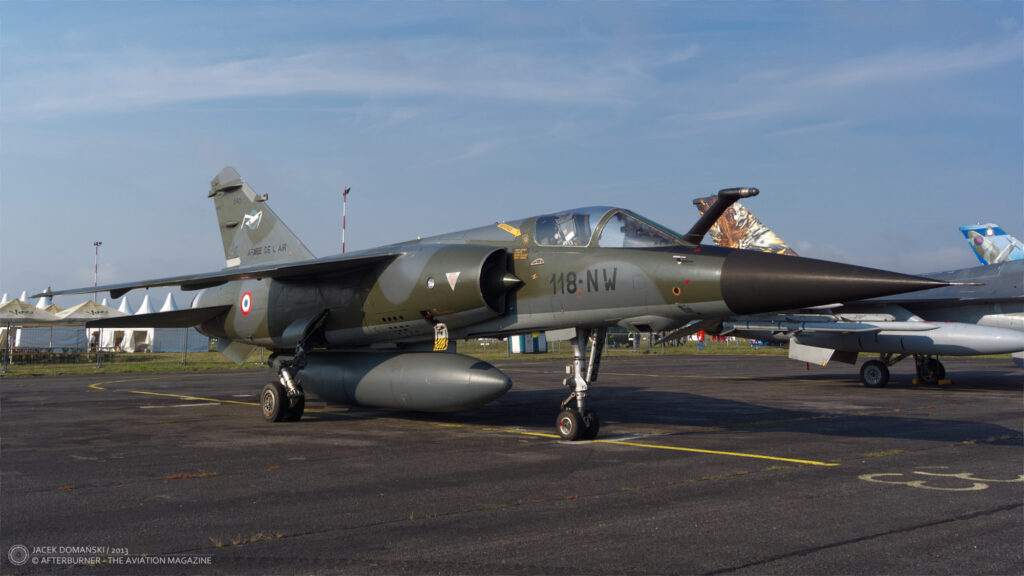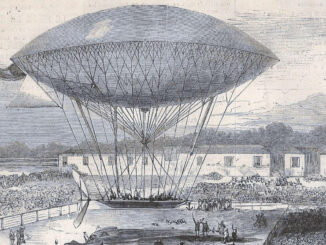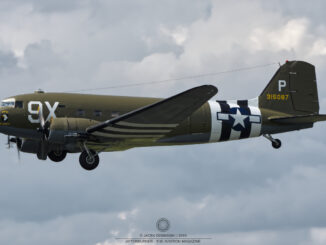 Dassault Mirage F1CR (c/n 646, 118-NW of Armée de l’air / the French Air Force), static display at Slovak International Air Fest, Sliać, August 2013.
Dassault Mirage F1CR (c/n 646, 118-NW of Armée de l’air / the French Air Force), static display at Slovak International Air Fest, Sliać, August 2013.
In the 1950s, French aircraft manufacturer – Dassault Aviation – developed a family of single-engine fighter aircraft, known as the Mirage. It all started in 1952 with study design, known as Mirage I. It was followed by a bigger variant, named Mirage II, and presented two years later. In 1956, the final design from that family – turbojet fighter designated Mirage III – performed its maiden flight and shortly after was approved for serial production.
In 1961, Mirage IIIC – as the first production variant was officially designated – was delivered to the French Air Force. The aircraft was well received and quickly gained popularity. Apart from Armée de l’air, the new fighter jet was also acquired by twenty other air forces all over the world and manufactured in more than forty different versions.
Taking advantage of successs of the Mirage III, during the 1960s the Dassault company launched a series of further developments, based on that fighter. All of them were done as a private venture and included a larger, swept-wing version of the Mirage III (known as the Mirage F2), a study of vertical take-off and landing jet (Mirage IIIV), as well as a smaller interceptor fighter aircraft (Mirage F3).
While most of the aforementioned projects had been consecutively abandoned, Dassault focused on further development of the F3 variant, although significantly redeveloped. This time, the works were acknowledged by the French government and secured by an official contract. The goal was to create an all-weather interceptor aircraft that could be a successor to the Mirage III fleet.
On 23rd December 1966, prototype of the new fighter made its first flight. The aircraft shared some of its construction elements with other Dassault developments. As an example, wings layout and tail section were taken from the F2, and the fighter was powered by SNECMA Atar engine, used with the Mirage IV. Regrettably, in May of 1967, the prototype was lost in an accident, killing the pilot.
Despite that tragic event, the new fighter was approved for the French Air Force, receiving official designation of Mirage F1. Works on the second prototype began almost immediately. That aircraft performed its maiden flight on 20th March 1967 and two months later, an order for the first, pre-production series of three aircraft was placed by the French military authorities.
Evaluation flights of the new Mirage fighter lasted until 1971. Finally, later that year, the first batch of eighty five fighters for the French Air Force was ordered. The Mirage F1 had officially entered service in December 1973, with EC2/30 Normandie-Niemen squadron.
The Mirage F1 was a swept-wing, single-engine interceptor, although having advanced ground attack capabilities as its secondary role. It was characterised by exceptional manoeuvrability, advanced avionics suite and radar, as well as significantly shorter take-off distance, comparing to the Mirage III. Maximum altitude of the F1 was at 65,615 feet and the aircraft was capable of exceeding Mach 2.
The new fighter followed the success of its predecessor – apart from the French Air Force, the Mirage F1 was operated by approximately dozen air forces all over the world. It also recorded an impressive combat history, including Operation Manta and Operation Epervier in Chad, the Gulf War, missions in Afghanistan, French operations in Mali, Paquisha War between Ecuador and Peru, the Cenepa War, the Iran-Iraq War and many other local conflicts.
The Mirage F1 fighters remained in active service with Armée de l’air until the mid-1980s, when it was succeeded by another Dassault design, the Mirage 2000. With the introduction of the latter, the F1 was assigned the role of reconnaissance aircraft.
The dedicated reconnaissance variant, designated F1CR, performed its maiden flight on 20th November 1981. The aeroplane could carry a dedicated equipment mounted in the fuselage – such as panoramic cameras, ground mapping modules and infrared scans – and a variety of additional sensors in external pods. The French Air Force ordered sixty four aircraft of the F1CR variant. They became operational in the late 1983 and remained in active service until 2014.
Until 1992, when the production of the Mirage F1 was finally ceased, more than 700 examples of that aeroplane were built. During the years, ten main variants of the F1 were developed, including a two-seat trainer, all-weather multirole fighter and a dedicated ground attack version.
Nowadays, a few Mirage F1 fighters are still being operated by private military contractors, such as Draken International. According to some reports, a small number of the F1 fighters can be still in active service in Congo and Gabon. Additionally, in 2005 the Royal Moroccan Air Force launched the MF 2000 ASTRAC upgrade programme that modernized their F1 aircraft to the level of Mirage 2000-5.
The aircraft featured today within our Photo of the Week series, represents the F1CR reconnaissance variant. In 2013, shortly before its retirement from the active service, that Mirage F1 was exhibited at static display of SIAF airshow – and that was one of the last opportunities to see that aircraft on public display.
After its withdrawal from the operational service, the Mirage F1CR ´118-NW´ was stored at Rochefort – Saint-Agnant airfield. According to Eurodemobbed web site, it was still reported there in 2019.



